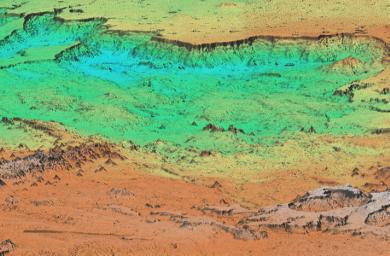This perspective view of Patagonia, Argentina shows a spectacular landscape formed by volcanoes, rivers, and wind. The area is located just east of the narrow range of the Andes Mountains, about 100 kilometers (62 miles) east of the border with Chile. Interesting features include basalt-capped mesas (top) and young volcanic cones (left foreground). Geologists will use SRTM topographic data to study the interaction of volcanic, climatic and erosional processes.
This shaded relief perspective view was generated using topographic data from the Shuttle Radar Topography Mission. A computer-generated artificial light source illuminates the elevation data to produce a pattern of light and shadows. Slopes facing the light appear bright, while those facing away are shaded. On flatter surfaces, the pattern of light and shadows can reveal subtle features in the terrain. Colors show the elevation as measured by SRTM. Colors range from blue at the lowest elevations to white at the highest elevations. This image contains about 1100 meters (3600 feet) of total relief. To emphasize subtle differences in topography, the relief is exaggerated by a factor of 5.
The Shuttle Radar Topography Mission (SRTM), launched on February 11, 2000, uses the same radar instrument that comprised the Spaceborne Imaging Radar-C/X-Band Synthetic Aperture Radar (SIR-C/X-SAR) that flew twice on the Space Shuttle Endeavour in 1994. The mission is designed to collect three-dimensional measurements of the Earth's surface. To collect the 3-D data, engineers added a 60-meter-long (200-foot) mast, an additional C-band imaging antenna and improved tracking and navigation devices. The mission is a cooperative project between the National Aeronautics and Space Administration (NASA), the National Imagery and Mapping Agency (NIMA) and the German (DLR) and Italian (ASI) space agencies. It is managed by NASA's Jet Propulsion Laboratory, Pasadena, CA, for NASA's Earth Science Enterprise, Washington, DC.
Size: 70 km (43 miles) x 70 km (43 miles)
Location: 41 deg. South lat., 69 deg. West lon.
Orientation: Looking South
Original Data Resolution: 30 meters (99 feet)
Date Acquired: February 19, 2000
Image: NASA/JPL/NIMA

 Planetary Data System
Planetary Data System












